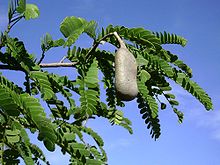In Western Africa, cocoa is a commodity crop grown primarily for export; 60% of the Ivory Coast’s export revenue comes from its cocoa.[9] As the chocolate industry has grown over the years, so has the demand for cheap cocoa. On average, cocoa farmers earn less than $2 per day, an income below the poverty line.[10]As a result, they often resort to the use of child labor to keep their prices competitive.[11]
The children of Western Africa are surrounded by intense poverty, and most begin working at a young age to help support their families.[12]Some children end up on the cocoa farms because they need work and traffickers tell them that the job pays well.[8] Other children are “sold” to traffickers or farm owners by their own relatives, who are unaware of the dangerous work environment and the lack of any provisions for an education.[13] Often, traffickers abduct the young children from small villages in neighboring African countries, such as Burkina Faso and Mali,[8] two of the poorest countries in the world.[14] Once they have been taken to the cocoa farms, the children may not see their families for years, if ever.
Most of the children laboring on cocoa farms are between the ages of 12 and 16,[15] but reporters have found children as young as 5.[16][19] In addition, 40% of these children are girls, and some stay for a few months, while others end up working on the cocoa farms through adulthood.[18]
A child’s workday typically begins at six in the morning and ends in the evening.[18] Some of the children use chainsaws to clear the forests.[17] Other children climb the cocoa trees to cut bean pods using a machete. These large, heavy, dangerous knives are the standard tools for children on the cocoa farms,[18] which violates international labor laws and a UN convention on eliminating the worst forms of child labor.[24][32] Once they cut the bean pods from the trees, the children pack the pods into sacks that weigh more than 100 pounds when full and drag them through the forest [17] Aly Diabate, a former cocoa slave, said, “Some of the bags were taller than me. It took two people to put the bag on my head. And when you didn’t hurry, you were beaten.”[4]
Holding a single large pod in one hand, each child has to strike the pod with a machete and pry it open with the tip of the blade to expose the cocoa beans.[18] Every strike of the machete has the potential to slice a child’s flesh. The majority of children have scars on their hands, arms, legs or shoulders from the machetes.[16] [19]
In addition to the hazards of using machetes, children are also exposed to agricultural chemicals on cocoa farms in Western Africa.[18] Tropical regions such as Ghana and the Ivory Coast consistently deal with prolific insect populations and choose to spray the pods with large amounts of industrial chemicals. In Ghana, children as young as 10 spray the pods with these toxins without wearing protective clothing.[17]
The farm owners using child labor usually provide the children with the cheapest food available, such as corn paste and bananas.[20]In some cases, the children sleep on wooden planks in small windowless buildings with no access to clean water or sanitary bathrooms.[21]
On cocoa farms, 10% of child laborers in Ghana and 40% in the Ivory Coast do not attend school,[2] which violates the International Labour Organization’s (ILO) Child Labour Standards. [18] Depriving these children of an education has many short-term and long-term effects. Without an education, the children of the cocoa farms have little hope of ever breaking the cycle of poverty.
To date, relatively little progress has been made to reduce or eliminate child labor and slavery in the cocoa industry of Western Africa. At the very least, the industry has agreed to work to eliminate what the ILO calls “the worst forms of child labor.”[23] These are defined as practices “likely to harm the health, safety, or morals of children” and include the use of “hazardous tools” and any work that “interferes with schooling.”[26]Approximately1.8 million children in the Ivory Coast and Ghana may be exposed to the worst forms of child labor on cocoa farms. [2]
Slavery
Recently, investigators have discovered children trafficked into Western African cocoa farms and coerced to work without pay.[3][5]Abby Mills, campaigns director of the International Labor Rights Forum, adds, “Every research study ever conducted in [Western Africa] shows that there is human trafficking going on, particularly in the Ivory Coast.”[33] While the term “slavery” has a variety of historical contexts, slavery in the cocoa industry involves the same core human rights violations as other forms of slavery throughout the world.
For the full article
Visit
http://www.foodispower.org/slavery-chocolate/
Sincerely
Rozzy Queen of Shea
www.facebook.com/queenofsheabutter



















